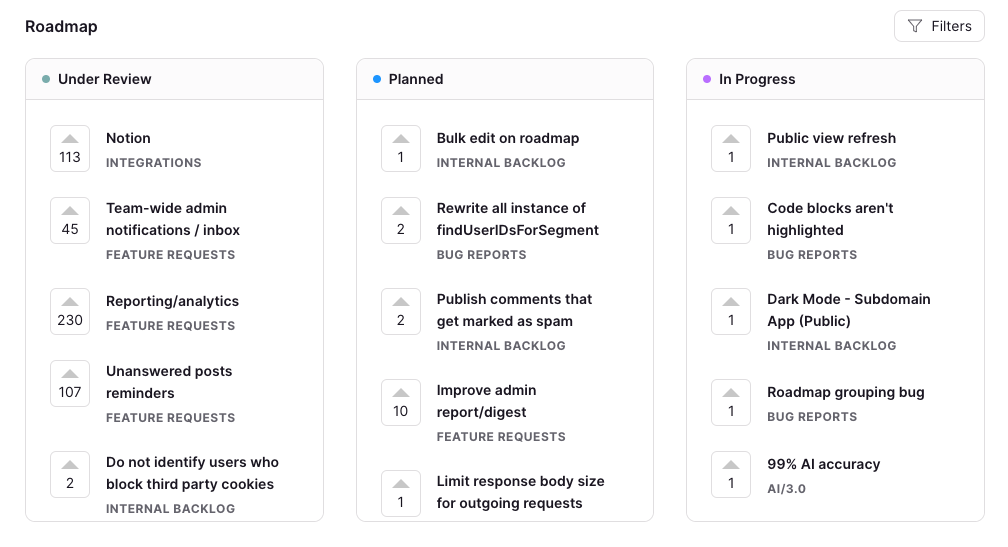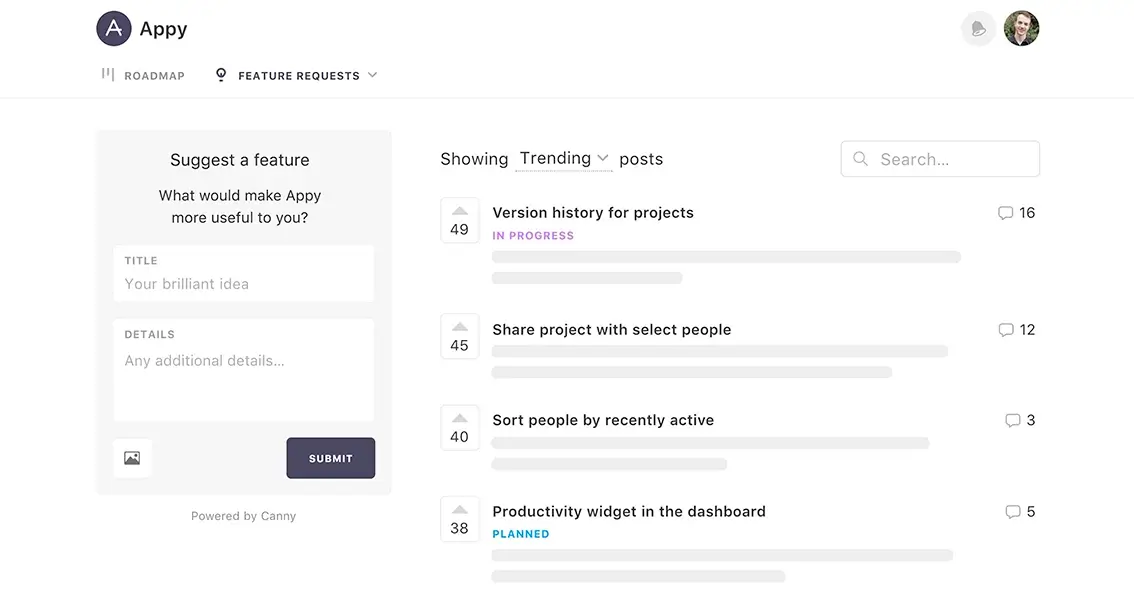Want to know exactly what steps to take to build a competitive product?
One of the most important steps is to have an innovation strategy. And, you need to know how to act on it.
That’s what you get with an innovation roadmap.
It might seem like innovation is hard to plan. Brilliant breakthrough products like the first smartphone might seem like a stroke of genius. In reality, many innovative products are carefully researched and planned. They don’t just happen.
The innovation roadmap helps you map your path towards growth and innovation. It also helps you navigate competitive pressures and market changes.
This post will guide you on this journey to innovation. We’ll explore the core elements of an effective innovation roadmap. We’ll also look at different types of innovations and how they drive business growth.
Many companies struggle to foster a clear focus on their innovation goals. By following innovation roadmapping best practices, you can overcome that.
Let’s dive in.
Understanding the innovation roadmap
An innovation roadmap is a plan that outlines how you’ll innovate. It plans projects that your innovation team thinks will deliver new, unique value.
This can help you gain a competitive advantage.
It’s more than just a timeline. It’s about planning how you’ll deliver value to your customers.

Innovation roadmaps guide businesses towards market leadership, setting strategic goals along the way. They help companies navigate through complex environments with confidence and precision. And like in any journey, buy-in from all stakeholders is crucial for success.
The core elements of an innovation roadmap
A good innovation roadmap has several key components:
- Vision
- Objectives
- Initiatives
- Timeframes
- Milestones
- Dependencies
- Resources
The vision sets out where you want to go – your ultimate goal or destination.
Objectives are what you need to accomplish on your way there. These should be specific and measurable.
Initiatives are projects or actions to meet those objectives. These could be feature requests, internal ideas, or bug reports.
Each initiative should have a timeframe specified. Often, you’ll specify whether it’s a short-term, medium-term, or long-term initiative. This helps you set clear expectations and timelines for meeting your objectives.
Milestones highlight key events in your roadmap. Often, milestones could be completing a specific initiative or group of initiatives.
You’ll want to identify dependencies. Some initiatives need to be finished before others can start. Identifying these lets you prioritize critical initiatives and build sequentially.
Each initiative’s resource requirements should be specified. These could include staff time, budget, software, etc. This is critical so you can prioritize your resources effectively.
Including all these elements in your roadmap helps you stay focused and on track.
The role of stakeholders in innovation roadmapping
Roadmapping can’t occur in isolation. You need participation from everyone involved. That includes stakeholders. They have vested interests and insights into various aspects of the business. Stakeholder buy-in helps your roadmap be a living document guiding your strategy. Without it, your roadmap may sit untouched on someone’s hard drive.
Companies with high stakeholder involvement have a higher chance of innovation success. So, consider regular touchpoints to update stakeholders about progress against goals.
Interested in other types of roadmaps? Check out our pieces on business roadmaps, technology roadmaps and marketing roadmaps.
Adaptability fosters innovation
Embarking on the innovation journey is thrilling, filled with possible discoveries and breakthroughs. Let’s make sure we’re holding the best map. Remember – our path may change, but as long as we focus on our goal, we can overcome any challenges.
Types of innovation
As you build your innovation roadmap, it’s useful to keep in mind what type of innovation you’re working on. Let’s discuss and illustrate some common types of innovation.
Product innovation
This type involves introducing new products or enhancing existing ones. Think about how Apple revolutionized the mobile industry with its iPhone. It’s a classic example of product innovation. But, it’s not just about creating something new. You have to make sure that ‘new’ offers significant value to customers.
Process innovation
Process innovations focus more on improving efficiency within an organization’s operations. The assembly line invented by Henry Ford is a shining example. It was unheard of that each worker would only work on one part of the process. But, it worked. It dramatically increased production speed while reducing costs.
Business model innovation
Business model innovations tackle changes in company structures and strategies. Companies like Uber and Airbnb didn’t invent anything novel. Both taxis and hotels existed long before these innovators. They just transformed traditional business models, leading to breakthrough innovations.
Service innovation
Service innovation focuses on improvements made towards customer services. Amazon Prime’s one-day delivery system is a great example. Customers loved getting their shipments in a day instead of several days. It boosted customer satisfaction with its innovation. And Amazon isn’t stopping there – they’re now offering 1-hour delivery!
Disruptive innovation
This is what most people think of when they hear “innovation”. A real breakthrough, something that no one has seen before.
Clayton Christensen introduced this concept in his 1997 book “The Innovator’s Dilemma.” It talks about innovation that creates a new market and value network. Eventually, it disrupts it. This disruption often replaces established market-leading firms and products.
Typically, products in this category start in a niche market. They often offer a unique competitive advantage and improve rapidly.
Netflix is a popular example in this category. It started by mailing DVDs. It transitioned to online streaming, eventually disrupting traditional cable TV.
Radical innovation
Radical innovation is also known as breakthrough or transformative innovation. Products in this category significantly differ from what currently exists on the market. These innovations often introduce entirely new paradigms. They can reshape industries or even create entirely new ones.
Radically innovative products involve a high level of risk (and potential reward). They take longer to develop and require lots of knowledge and capabilities. Most importantly, they present a fundamental change.
Electric cars are a great example of this category. The concept of electric vehicles (EVs) isn’t new. However, advancements in battery technology have positioned EVs as a radical innovation.
Incremental innovation
Incremental innovation is a series of small improvements or upgrades. You can apply incrememntal innovation to existing products, services, processes, or methods. Incremental innovation is the opposite of radical or disruptive innovation. It doesn’t typically involve significant breakthroughs or entirely new approaches. Rather, it plays the long game. It’s also lower risk than other types of innovation.
An example could be a software update that fixes bugs. It’s not a massive change, but it’s still important and valuable.
Architectural innovation
Architectural innovation reconfigures existing product’s components in a new way. The core design concepts and main components remain largely unchanged. This type of innovation changes the relationship between the pieces of the problem. It does that without changing the pieces themselves.
Here’s an example. Web hosting shifted from centralized servers to distributed cloud-based servers.
As you were reading this, one or two types and categories of innovation might’ve resonated with you the most. If so, keep them in mind as you continue reading.
Building your innovation roadmap
Now that you know what to include in your roadmap, you can start building it.
An innovation roadmap is a visual representation of your innovation journey. It charts the course from ideation to implementation. Here’s a step-by-step guide to building your innovation roadmap:
1. Define your goals:
- Start with the end in mind. What do you hope to achieve with your innovations? Entering a new market? Improving customer experience? Increasing operational efficiency? Whatever your aims, make sure you have clear objectives.
2. Gather insights:
- Dive deep into market research, customer feedback, and industry trends. Understand the gaps in the market and the needs of your customers.
3. Brainstorm ideas:
- Bring together a diverse team and encourage free thinking. Use techniques like design thinking or SWOT analysis to generate a plethora of ideas.
4. Prioritize initiatives:
- Not all ideas are created equal. Evaluate each one based on its potential impact, feasibility, and alignment with your goals. Check out our post on product prioritization to see how to best do this.
5. Allocate resources:
- Determine the budget, staff time, and time required for each initiative. Make sure you have the necessary resources to bring your ideas to life.
6. Set milestones:
- Break down the innovation process into manageable chunks. Set clear milestones with deadlines to keep the team on track.
7. Visualize the roadmap:
- Use tools or software to create a visual representation of your roadmap. This will help in communicating the plan to stakeholders and keeping everyone aligned. You can get Canny’s roadmapping software for free.
8. Gather feedback and iterate:
- Once your roadmap is in place, share it with a broader audience. Gather feedback, make necessary adjustments, and ensure it remains a living document.

9. Monitor progress:
- Regularly review your roadmap. Track progress against milestones, celebrate successes, and address any roadblocks.
10. Evolve and update:
- The innovation journey is dynamic. As market conditions change and new insights emerge, revisit and update your roadmap to stay relevant.
Building an innovation roadmap is a collaborative and iterative process. It provides clarity, direction for your team. And, it ensures that your innovative ideas translate into tangible results.
Chart a course for innovation
Innovation certainly isn’t a breeze. But, with an innovation roadmap, you can give yourself a great shot at successfully innovating.
Remember – they’re not just useful for creating products. They also help innovate processes, business models, and services too.
The innovation management process is key to successful business growth. And, innovation roadmaps are one of the best tools to help that process.







